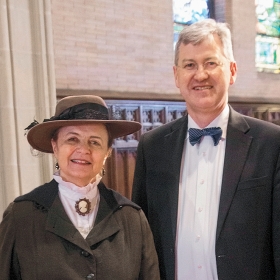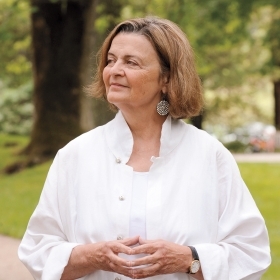As H. Kim Bottomly, Wellesley’s 13th president, prepares to hand over the keys to the College on July 1, I’ve thought back to the many times I’ve seen her in action.

Bottomly, with Provost Andy Shennan at the Great Fire commemoration
Part of my job as editor is to be boots on the ground at myriad College events—from symposia to memorial services to commencement. Taking part in those gatherings, I get to see a lot of another person whose role it also is to be a presence for the College: our president.
As H. Kim Bottomly, Wellesley’s 13th president, prepares to hand over the keys to the College on July 1, I’ve thought back to the many times I’ve seen her in action. Presiding over Academic Council, the faculty legislative body, calmly trying to keep a firm hold on the reins of a galloping debate. Driving to class social hours in a torrential downpour to greet returning alumnae at reunion. Presenting flowers to a fleet-footed senior at Hooprolling—and avoiding the splash when the winner goes into the lake.
One of my favorite memories is from the commemoration of the 100th anniversary of the Great Fire, celebrating the vibrant institution that emerged from the ashes of College Hall. We had a community breakfast in the Chapel, where the Wellesley community had gathered as the ruins smoldered a century before. Present-day students and faculty read period letters aloud, making the shock of the conflagration entirely vivid.
Wonderfully, Kim turned up in Edwardian dress, complete with a long skirt, a hat with a wide black band, and a cameo at the neck. When she got up to greet attendees, she had an admission. “I just want to say, it was complicated being a president—or a woman—in those days,” she said. “There’s a cane. There are gloves. I’ve already lost one of the gloves. Turns out you can’t turn pages when you have gloves on. But the good news is, I’m not entirely authentic. I decided not to wear the corset for the occasion.” The crowd hooted.
I just want to say, it’s complicated being a president today. You are the public face of the College in moments of great institutional pride and in moments of tremendous tragedy or controversy. You might have to find words of comfort for shell-shocked students who have lost of one of their own. You and your institution might be the target of stinging criticism—from individuals or the national press. You have to be a consummate diplomat and an empathetic listener. If the stock market tanks during your tenure, you have to make enormously difficult decisions about College priorities, and how many employees will be laid off in budget cuts. You have to be a risk-taker and a visionary—what initiatives will keep the College at the pinnacle of higher education for decades to come?—and you have to be a tireless leader who can endure a pounding schedule.
The array of skills required to be a college president is mind-boggling. Madeleine Korbel Albright ’59, who knows a thing or two about challenging jobs, calls the role “one of the more difficult things one could do.” As you’ll read in our cover story, “The Steady Hand,” Kim negotiated her presidency with quiet equanimity. Dean Katherine Lynch says that she has led “from a position that is completely and entirely without ego.” Trustee Emeritus William Kaiser praises her “analytical intelligence, her courage and strength, and her willingness to try new things.” Professor of Sociology Jonathan Imber calls her “an honest broker, fair-minded, and a loyal and dedicated friend of our College.”
As Kim prepares to set aside the presidential hat, gloves, cane, and (yes, sometimes) corset, we applaud her steady, kind leadership and all the ways it has transformed and strengthened Wellesley.

